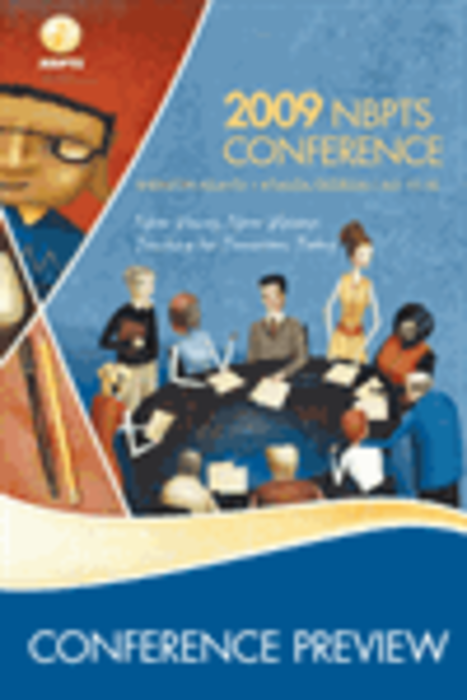When it comes to direct mail, success can be measured in a variety of ways besides straight ROI — although raising response is, of course, the bottom line. For instance, did the piece grab attention? Did its design help it get past the gatekeepers? Or, was the mailing particularly cost-efficient? Did it help increase customer loyalty? These are the factors that came into play for the following three successful direct mail campaigns. A b-to-b campaign, a campaign touting an education nonprofit and a mailing strictly for high-end luxury auto enthusiasts may not initially seem to have much in common. But they are all efforts that effectively used direct mail in creative and thoughtful ways. ?
Cost-savings savvy?
As an education nonprofit that relies on federal and state funding to survive, the National Board for Professional Teaching Standards (NBPTS) was looking to cut down on direct mail campaign costs, which — while mail remains an essential marketing channel for the organization — can be prohibitively expensive. ?
For a mailing promoting a conference that targeted 74,000 national board certified teachers, director of marketing Elizabeth Arritt had an idea of how to cut down on the number of mailers sent out: “We were already planning e-mails and mailings and I thought, why am I e-mailing all these people and then mailing something when I can tell exactly who opened the e-mail?”?
The NBPTS had about 61,000 of the targeted group’s e-mail addresses, so each one received an HTML preview e-mail for the conference twice during the span of one month. Arritt then tracked the addresses that opened the e-mail – about 11,000 – and removed those from the mailing, then targeted the mailing to states near the conference or where the organization had a strong presence, so only about 45,000 of the mailed pieces were sent out. ?
“It saves us anywhere from $5,000 to $10,000 per mailing, between print and mailing costs,” says Arritt. This type of cost savings effort is becoming part of the organization’s standard marketing procedure now, she adds. “We haven’t bought any lists,” she says. “Instead, we’ve gotten information from those who follow us on Twitter and Facebook as well as sign-ups on the Web site.”?
Lead with loyalty?
To mark the debut of the new Porsche 911, Porsche Cars North America’s agency, Cramer-Krasselt Chicago, sent unique direct mail kits to a curated list of 10,000 Porsche enthusiasts, including current and former 911 owners. Each package included an exclusive, limited-edition Porsche badge that was personalized with a unique code, in some cases hand-selected for a specific recipient. ?
“Our drivers are as important in developing the brand over time as the brand itself,” says Michael Baer, group account director for Porsche at Cramer-Krasselt Chicago. “We always want to stay in contact with them, give them insider information and, when and where, it’s appropriate, reward them for their passionate loyalty to the brand.” ?
The effort was part of a large marketing push that included print and online ads as well as a microsite. But the response to the direct mail piece and badge was particularly positive, says Baer. Some recipients even took the time to write Porsche and personally thank them for the gift. ?
The creative challenge for the direct mail piece, he says, was the fact that the new Porsche 911 doesn’t look that much different than the prior generation — so the company had to work carefully to get to the sweet spot of Porsche insiders who have owned multiple Porsches through the years and explain the differences in the new model. “The outside looks unchanged, but on the inside it’s a completely new car,” he says. ?
Still, the main driver (no pun intended) for the direct mail piece was loyalty — offering top customers something they could put on their desk as a keepsake about their cars. “Anecdotally, we know it drove sales, but it wasn’t designed for that,” says Baer. “It was a reward for loyalty, longevity and interest with the brand. There was no ROI on this piece.” ?
Dimensional dynamo?
When it comes to dimensional direct mail for business-to-business companies, agency Mindspace knows its stuff. After all, it has completed more than 250 dimensional mail campaigns for enterprise software company Oracle. ?
“Especially when the piece goes to a C-suite executive, where it’s hard to get through the doorkeeper — that is, the receptionist — we find if it’s in a dimensional box that stands out it gets pushed through pretty quickly,” says Brent Shetler, principal and creative director at Mindspace. “We’ve seen 20% response rates with mailers when we either send it in a box that’s interesting or just by FedEx so that it has a sense of importance to it.” ?
Last summer, the agency created a direct mail campaign for Oracle distributor Avnet, which wanted to get its value-added reseller (VAR) clients — who sell Oracle products to end users — to sign up for a lead-generation campaign to sell Oracle’s new line of business intelligence products. Twenty-five VARs received a unique, Get Smart-themed spy kit piece which included a brochure and video PDF about the program, explaining everything the reseller needed to know to make a decision about participating in the campaign. ?
Mindspace hoped to sign up 10 of the VARs, but it actually got 16 — a more than 64% response rate. While it was a small target base, the subsequent lead generation campaign was sent out by the VARs to about 1,400 prospects and included a similar spy briefcase 3-D mailing driving recipients to a personalized landing page. The 3.5% response rate generated 50 leads for the VARs – offering potential sales of more than $5 million. “With price points for the solutions starting at around $100,000, you can justify significant spend [for a mailer],” says Shetler. l?








